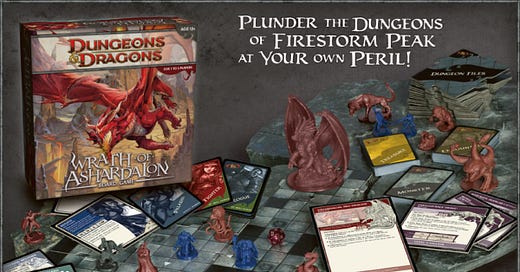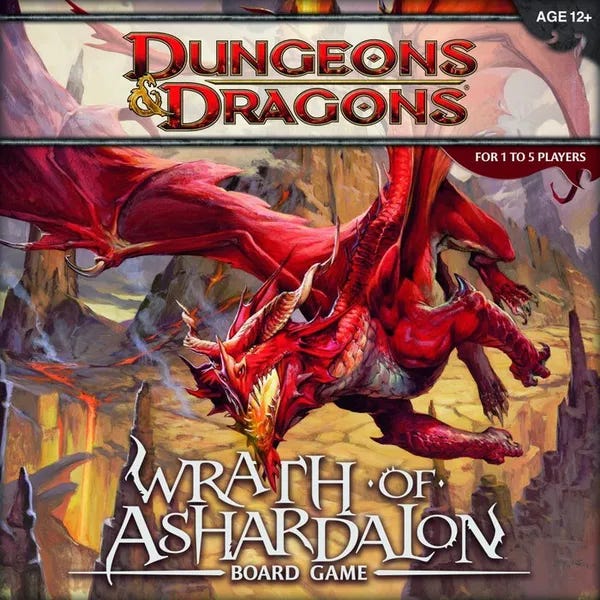How Wrath of Ashardalon Can Be a Great Way to Introduce People to D&D
Dungeons and Dragons is many things to many people, and with the resurgence spawned by the 5th edition's release, there's perhaps never been more people playing the game. Nor have there ever been as many ways to play the game. Some like to focus on the action, some on the strategy, and others love to put the focus on story and characters above all else. While Wrath of Ashardalon may not cover all the bases, it does have enough to be a great way to introduce people to the idea of D&D and tabletop roleplaying.
Wrath of Ashardalon, along with Temple of Elemental Evil and similar board games, can be referred to as mini-RPGs. They are actually more "board" than "role" and definitely favor the strategy aspect moreso than character, story or the many other pieces of the puzzle that make Dungeons and Dragons and other RPGs like Pathfinder so great. But Wrath of Ashardalon does have one big thing going for it...
You can play through a mission in about 15-20 minutes.
Dungeons and Dragons takes a looooooooonnnnnnnggggg time to play. A two-to-three hour session could easily be used up simply hanging out in a tavern and having the characters meet up with an NPC that wants them to go find some lost jewel or guard his caravan. An actual dungeon quest could span an entire night or even several game sessions, depending on how big the dungeon and how much the players love the roleplaying side.
It's fun. But it's time-consuming.
This time consideration can be a real deterrent to those who might otherwise be curious about the game. And first sessions often take several hours and rarely show the full majesty of the game. That's where a game like Wrath of Ashardalon comes into the picture.
As I mentioned above, these games are more board than role-playing. Each player (there is no DM) starts with a character and the choice of a few cards that represent the powers they can use. The dungeon is created by drawing from a deck of cards and laying them on a table based on where the players have decided to explore. This simple random dungeon generation is part of the genius of the game, and each section that is revealed often contains either a monster, a trap or some other attraction.
The fun part is that the party is urged to continue exploring even during battle otherwise more baddies can appear. This keeps the game fast-paced and action-packed. There's a certain sense of urgency during the entire session, which rarely exceeds 30 minutes once you get used to the rules.
Character advancement is minimal. You can gain a single level with your character and most true advancement happens by way of the items you find. Even these usually provide only small bonuses.
It's a simple game, which is why it is such a great introduction. Newbies can easily be up-and-running in about the same time they might learn how to play Exploding Kittens, while the sense of choice and the decisions that come with doing battle against kobolds, orcs and other baddies certainly are reminiscent of a good, old-fashioned game of D&D.
Wrath of Ashardanan is available on Amazon.com. (Affiliate Link)
Roleplaying? Minimal. Obviously, this depends on the players themselves, but you won't have a session that is 90% the characters and NPCs simply talking to each other. You won't get the sense of intrigue or the rich story, although each mission does have its own (mini?) story that plays a part in the overall campaign. But despite being a miniaturized version of the real deal, these board games can be a great way to introduce the idea of role-playing to friends and family.
They are also a whole lot of fun and a great way to do game night.
The only real downside may be the price. They can be expensive. Wrath of Ashardalon can set you back around $50 and some of the similar games like Temple of Elemental Evil or Dungeon of the Mad Mage can be even more expensive. But considering it's really less than the cost of a group going out to the movies and comes with more than just 2 hours of entertainment, it's a pretty good deal.
I based my Dungeons of Evermore mobile game (iOS / Android) on the same basic concept. The idea of doing a digital version of these games was appealing because so much more could be done on a mobile device, including adding more levels to character advancement.
Note: This article contains links to Amazon products via the Amazon Affiliate program. As an Amazon Associate, I earn from qualifying purchases.




